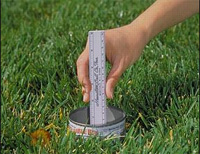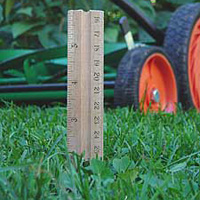 |
||
Ron’s ArticlesIt’s Turf Tune-Up TimeApril 2006 It’s turf tune up time! The last average freeze date is past, the soil is warming up and things are greening up. You can see where your turf needs help. Our turf grasses aren’t native. So, if you crave thick healthy green turf you must feed it. Experiments with my landscape clients have proven that several light feedings are best. Ten to 15 pounds of organic fertilizer per 1,000 sq ft every 10 to 12 weeks is ideal. The roots grow deeper so you need less water. Sprinkler Check: Place the tuna cans in dry spots, green spots, and near sprinkler heads... basically just scatter them all over the yard. When done measure how much water landed in each can. If ½-inch of water landed in each can then you have a great sprinkler system. Too much water... cut back on time. Not enough water... increase time. Tuna cans unevenly filled indicates that an adjustment needs to be done to the sprinkler heads, or add a new head to cover dry areas. Where you find cans less than ½-inch filled, find the cause - a misdirected or clogged head? Has a shrub grown up to interrupt the spray? Then repeat with station 2, etc. Cutting Level: For your first cutting, lower your mower to 1-inch for Bermuda or 1½-inch for St Augustine to cut off the dead brown stuff so the new green growth will start at a low level. Then, raise your mower about ½-inch a month - less if it’s cool and wet, more if it’s hot and dry. By August you’ll be at 3-inches or more. This helps retain moisture, keeps roots cooler and protects the soil’s carbon from the rays of the sun. Bermuda needs 8 pounds of nitrogen a year. St Augustine only needs 4. Nitrogen should be blended with beneficial elements. Our Spring, Summer and Fall Blends include more than 20 ingredients - each has a specific purpose. If you want to blend your own fertilizer, feel free to stop by our garden center to check out the ingredients we use. Cornmeal stimulates trichoderma that feed on fungal pathogens. Alfalfa meal contains tricantanol, a powerful growth hormone that first stimulates root growth and then top growth. Slightly acidic sul-po-mag balances our alkaline soil and water. Molasses feeds the soil microbes and improves insect resistance. And, the list goes on. Check for turf patches that aren’t greening up. Rake vigorously, then water. The remnant stolons and rhizomes may root. If after a week there is no sign of growth, ask, “What caused this?” Correct the problem or your grass won’t grow. Grubworms attack poorly established root systems. You can pull the grass up like a carpet. Did the area stay too moist? Too dry? Chinch bugs favor areas that are too dry. Is your Bermuda getting too much shade? If your lawn isn’t well graded, water drains to low areas where it compacts the soil and squeezes out the oxygen. Should you aerate the area and throw down some compost to level it out gradually? If your turf has major damage, new sod may be the answer. Fall is the best time to resod, but April is the next best. Careful planning reaps the best results. Buy the freshest sod and install it as soon as possible. Do all the preliminary work before your sod is delivered. Sod on a pallet is viable for 48 hours at best. Laying sod over turf never works. Tilling is essential. Rent a self-propelled hydraulic tiller. With the wheels going forward and the tines in a rear motion you can control it to till only the top two inches of soil minimizing damage to tree roots. Rake off all loose grass. Move soil as needed to create a high point with a slight grade so water drains off in the right directions. Line up at least one helper, a wheelbarrow, enough hoses to reach the point furthest point from your spigot, a sod roller and plywood to lay out a runway if you must transport sod over newly laid sod. DO NOT spread compost. As compost continues to decompose it generates heat in excess of 100 degrees. This damages the grass roots and robs nitrogen from the soil. Nature never rips up established prairies to put down compost. A 5-gallon bucket of earthworm castings per 500 square feet is great pre-sod soil amendment. DO NOT use the top or bottom layers of sod from the pallet. The top layers are dried out and the bottom layers are compacted. Start at your longest straight sidewalk to lay a nice straight line of sod. Always use long strips against sidewalks. Small pieces dry out too easily. Have your helper follow behind watering in each piece as it’s laid. When all the sod is down, top dress with a cubic yard of compost per 1,000 sq ft. Critical: Roll the sod to eliminate air pockets and get the roots in touch with the soil. Then, watch the weather and water often enough to keep the sod from drying out. But, stretch it out as much as possible to encourage the roots to seek water from the soil. 
|
|
|


|
||
 An annual sprinkler check is critical. Things change. The tuna can method works well. Put a half dozen out in the area of station 1. Run it for 15 to 30 minutes.
An annual sprinkler check is critical. Things change. The tuna can method works well. Put a half dozen out in the area of station 1. Run it for 15 to 30 minutes. Never scalp your turf!
Never scalp your turf!